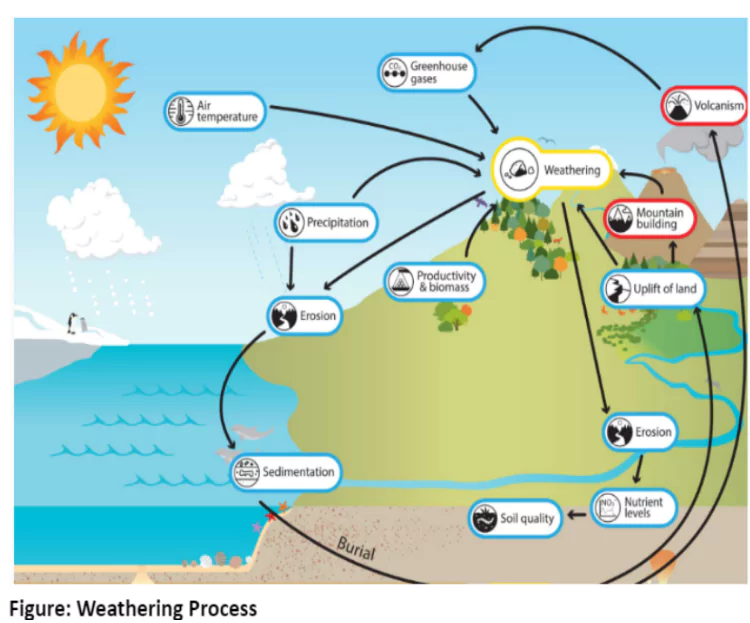Weathering is defined as the mechanical disintegration and chemical decomposition of rocks through the actions of various elements of weather and climate. It is an In-Situ or Onsite process. This can happen in two main ways: mechanically, where rocks are physically broken apart, and chemically, where rocks are broken down by chemical reactions. Factors like the type of rock, the weather and climate in an area, the shape of the land, and the presence of plants all influence how weathering occurs. Understanding weathering helps us learn how landscapes change over time.
Classification of Weathering processes
Weathering processes are grouped into two main categories: Chemical Weathering, where rocks are broken down by chemical reactions, Mechanical Weathering, where rocks are physically broken down into smaller pieces, and Biological Weathering where plants and animals carry out the weathering process.
Chemical Weathering Processes

- It includes solution, carbonation, hydration, oxidation and reduction. Water, air and heat are vital for accelerating chemical reactions.
- Solution: Dissolution in water or acid. Minerals like calcium carbonate and calcium magnesium bicarbonate present in limestone are soluble in water containing carbonic acid.
- Carbonation: Process of atmospheric carbon dioxide causing solution weathering; common process helping in breaking down of felspar and carbonate minerals.
- Hydration: Minerals take up water and expand which increases the volume of the material (Calcium sulphate+water= Gypsum).
- Continued repetition leads to physical weathering through exfoliation and granular disintegration.
- Oxidation and Reduction: In oxidation, rock breakdown occurs due to the disturbance caused by addition of oxygen.
- When oxidized minerals are placed in an environment where oxygen is absent (eg: below water table/ waterlogged areas) reduction takes place.
Enroll now for UPSC Online Course
Physical or Mechanical Weathering Processes
- Physical or mechanical weathering refers to a process that relies on applied forces. Most of the processes are caused by thermal expansion and pressure release. These forces could be gravitational forces, expansion forces, and water pressures.
- Unloading and Expansion: In areas of curved ground surface, arched fractures tend to produce massive sheets or exfoliation slabs of rock.
- Large smooth rounded domes called exfoliation domes are a result of this process.
- Temperature Changes and Expansion: Most effective in dry climates and high elevations where diurnal temperature changes are drastic.
 Freezing, Thawing and Frost Wedging: Most effective at high elevations in mid-latitudes where freezing and melting are often repeated.
Freezing, Thawing and Frost Wedging: Most effective at high elevations in mid-latitudes where freezing and melting are often repeated.-
- Freezing involves the transformation of water into ice.
- Thawing is the process of melting ice back into water, and
- Frost Wedging is the mechanical breakup of rocks caused by repeated freezing and thawing cycles.
- Salt weathering: Salts in rocks expand due to thermal action, hydration and crystallisation. Salt crystallisation is the most effective of all salt weathering processes.
- Exfoliation occurs when curved sheets of material peel away from rocks due to temperature-induced expansion and contraction.
- Exfoliation domes are large and smooth rounded domes formed due to unloading and expansion of rocks.
- Exfoliation tor is smooth surfaced and rounded small to big size boulders, formed due to temperature changes and expansion in rocks.
|
Biological Weathering
- It involves organisms and includes:
- Organism Growth: It involves burrowing and wedging activities by creatures like earthworms, termites, and rodents that expose fresh surfaces.
- Organic Matter Decay: Decomposing plant and animal matter generates humic, carbonic, and other acids, promoting the decay and solubility of certain elements.
- Root Pressure: mechanically breaking apart earth materials.
Conclusion
Weathering, the process of rocks breaking down, is a crucial element in shaping Earth’s landscapes. It occurs through various methods, including chemical reactions, physical forces, and the actions of living organisms. By understanding how weathering works, we can gain insight into the ever-changing nature of our environment and the forces that shape it over time.
![]() June 1, 2024
June 1, 2024
![]() 4096
4096
![]() 0
0

 Freezing, Thawing and Frost Wedging: Most effective at high elevations in mid-latitudes where freezing and melting are often repeated.
Freezing, Thawing and Frost Wedging: Most effective at high elevations in mid-latitudes where freezing and melting are often repeated.